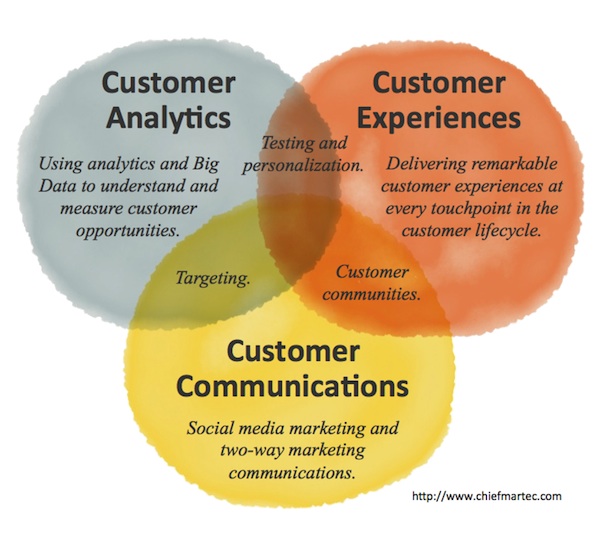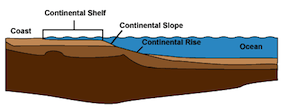
Here’s another way to visualize the relationship between big data and the other innovations happening in the marketing department.
I propose that there are three epicenters of innovation in modern marketing:
The first is customer communications and the revolution brought about by social media. Marketing communications has, rather quickly, moved from being a one-way broadcast to a more personal, two-way interaction with customers, prospects, and influencers, all interconnected together.
Organizations have had to embrace operational and cultural changes to adapt — many are still wrestling with those changes. But while technology certainly triggered this wave of innovation in customer communications, the software in this space is probably the least technically challenging for marketers to adopt. There is great innovation in this sphere, but it’s not primarily technical in nature.
The second is customer analytics, using analytics and big data to better understand and measure customer opportunities. There is unquestionably a lot of value to be unlocked here, which is why the “data revolution” in marketing is so big right now. However, these innovations are generally much more technical in nature.

While there are some easy first steps here — high-level dashboards, basic web analytics, and data visualization tools such as Tableau — the technical water quickly gets deep. I picture it like a “continental shelf” of shallow data analytics. Once you drop off the edge into the deep data ocean, the software is considerably more complicated and isn’t nearly as plug-and-play.
To really master customer analytics requires harder skills, such as statistics, modeling, predictive analytics, programming, data mining, etc. Acquiring these skills and integrating them into the marketing team will likely take more time and effort than the adoption curve associated with social media.
The third is customer experience, delivering remarkable customer experiences at every touchpoint in the customer lifecycle. In our digitally-malleable world, marketers can now wield technology to craft customer experiences that are powerfully differentiated — on a scale that was impossible to conceive not too many years ago.
I believe that the scale of this “experience revolution” will dwarf the other two.
There’s already a growing customer experience movement in the marketing department — with the embrace of user experience and design (not just art/graphic design) professionals. But ultimately code is the clay from which most of these experiences are sculpted. It’s with a mix of pre-packaged marketing software, custom developed applications, technical configuration, and plenty of “script” glue to tie everything together that these experiences are actually built and delivered — leveraging the state-of-the-art in hardware technologies (e.g., the latest smartphones and tablets) and major web services (e.g., the latest capabilities in Facebook).
Understanding how these technologies can be synthesized into compelling customer experiences — and having the technical capabilities to execute on those visions — presents a significant challenge for most marketing teams. But the opportunity is huge, strategically elevating marketing from communications to experiences. Marketing is still the champion of the brand. But the brand is now fully a direct function of customer experience.
This mission is “big experience.”
Big experience is nearly unlimited in the innovations that lie ahead. They’re not all technical in nature, but a significant portion of them are rooted in technology. To pursue these opportunities, marketing must expand its technical capabilities beyond data analytics. This is why marketing technologists, not just data scientists, should be a part of every marketing team’s growth plans moving forward.
Of course, some of the most fascinating areas in marketing are at the intersections of these three domains. For instance, the intersection between customer analytics and customer experience, where personalization and big testing are sprouting.
Fundamentally, modern marketing is about combining all these innovations into a cohesive strategy and operational structure.
That is why, although big data is big, it shouldn’t distract marketing leaders from constructing an organization that is capable of orchestrating all of these innovations together into a powerful and differentiated brand for the 21st century.



